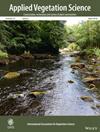In the Footsteps of Sheep Herds: The Neonative Xeranthemum cylindraceum Has No Impact but Indicates Ruderalisation of Overgrazed Pastures in the New Range
Abstract
Aim
Intracontinental range expansion of organisms is expected to be more and more frequent due to anthropogenic climate and land-use changes, but its impact on ecosystems and consequences to nature conservation or economy are not well understood. Our study focuses on a range-expanding neonative annual plant, Xeranthemum cylindraceum (Asteraceae, tribe Cardueae), which has become common in pastures. We aimed to assess the potential impact of this species on recipient grassland communities in the new range and to compare its performance between the native and neonative range.
Location
Grasslands in Romania (neonative range) and Bulgaria (native range).
Methods
We surveyed plots from very low to very high abundances of the target species in grassland stands. To compare the vegetation between cover categories of X. cylindraceum and between the two study regions, we calculated species richness, Shannon diversity and community weighted mean of Ellenberg and disturbance indicator values. We also compared the vegetation composition based on species life span, habitat preference and guild.
Results
Our results show that species richness and diversity do not decrease with the increasing abundance of X. cylindraceum in recipient grasslands. However, the cover of specialist and long-lived species was lower, while that of ruderal and short-lived species was higher in vegetation patches with medium to high X. cylindraceum abundance. In the neonative range, this pattern overlapped with an increased disturbance severity and soil nitrogen content indicated by community composition, which bears clear signs of grazing disturbance forcefully transforming plant composition and causing ruderalisation.
Conclusions
We conclude that the range-expanding X. cylindraceum does not raise conservation problems, since it is not impacting recipient grassland communities in its neonative range. However, it appears to benefit from grazing disturbance. As a toxic, unpalatable species, it decreases the economic value of intensively used grasslands, pointing out the need for decreasing stocking rates in intensively used pastures.


 求助内容:
求助内容: 应助结果提醒方式:
应助结果提醒方式:


